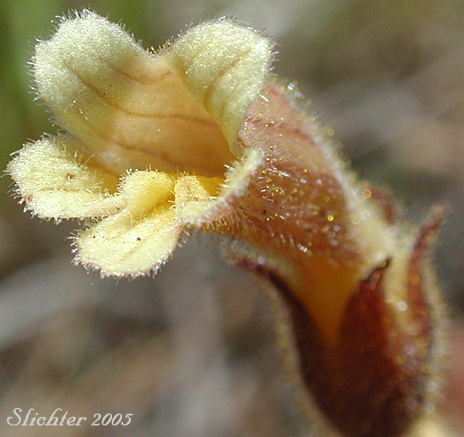 The
photo at right shows a close-up frontal view of the tubular corolla of clustered
broomrape as seen at about 4100' on the southeastern slopes of Mt. Adams.........June
10, 2005. Note the numerous hairs on the palate and inner surface of the corolla
lobes.
The
photo at right shows a close-up frontal view of the tubular corolla of clustered
broomrape as seen at about 4100' on the southeastern slopes of Mt. Adams.........June
10, 2005. Note the numerous hairs on the palate and inner surface of the corolla
lobes.
Clustered broomrape is a wildflower with solitary to clustered stems from 5-10 cm long that are buried. The pedicels are erect and extend from the ground from 7-24 cm high. The herbage is yellowish to reddish-purple (See photo above.) with numerous gland-tipped hairs on both the corolla and calyx. The long pedicels lack bractlets. The plants entirely lack chlorophyll.
The inflorescence consists of 4-10 flowers The calyx is 8-11 mm long with the tube measuring 4-6 mm long and the short, broadly triangular and pointed lobes from 3-5 mm long. The corolla is dull reddish (although yellowish flowered individuals are possible as seen in the photos on this page) with violet lines and yellow patches between the lobes of the lower lip. The corolla is 18-25 mm long with a curved tube while the corolla lobes are 2-6 mm long. The anthers are 1.5-2.0 mm long and range from glabrous to woolly.
Aphyllon franciscanum is very similar to Aphyllon fasciculatm but parasitic upon Eriogonum sp., Eriophyllum lanatum, Phacelia sp. and others but not on Artemisia sp.
Aphyllon fasciculatum is only parasitic upon Artemisia sp.
Clustered broomrape may be found between the elevations of 1200-3000 meters in dry habitats including those with shadscale, sagebrush, pinyon pine or juniper.
Clustered broomrape may be found fro the southern Yukon south to northern Mexico and east to Alberta and south to Oklahoma, Illinois and Indiana.
In the Columbia River Gorge it may be found between the elevations of 200'-3000' from near Catherine Creek east to Biggs, OR.